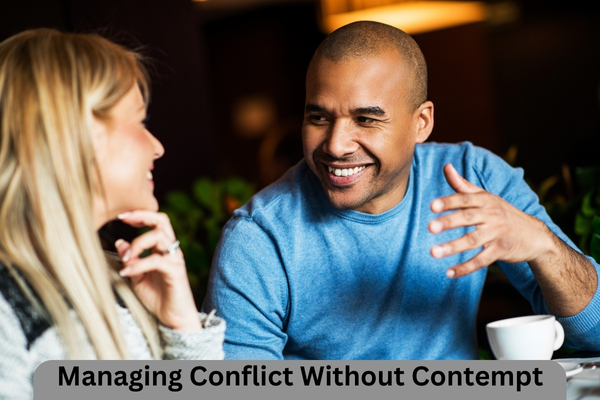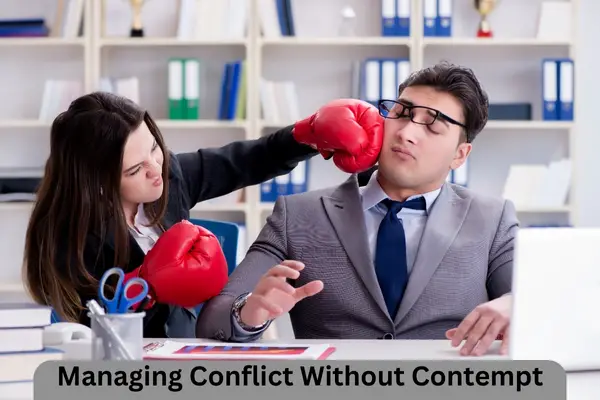Managing Conflict Without Contempt
No marriage is immune to conflict. Disagreements, large and small, are inevitable over issues like money, intimacy, division of labour, child-rearing, and more. However, research shows that how couples communicate during and after arguments, rather than the disagreements themselves, determines whether relationships last.
Specifically, communicating with contempt by insulting your partner’s character can inflict deep wounds that are difficult to repair. If unchecked, contempt erodes affection and ruptures bonds over time.
Fortunately, couples can sidestep communication landmines by using research-backed strategies for managing conflicts in more constructive ways.
By identifying root issues, taking breaks when needed, actively listening, expressing needs with “I” statements, and compromising, couples can navigate disputes without attacking each other’s essence. Strengthening these communication muscles can deepen understanding and intimacy even during times of strife.
The Dangers of Communicating with Contempt
Contempt goes beyond criticism into belittling your partner through hostile humor, sarcasm, name-calling, and mocking. It conveys disgust and superiority by insulting the other person.
Researchers have found that different forms of contempt, such as rolling your eyes, sneering, mockery, and hostile humor are among the biggest predictors of divorce.
Displaying contempt activates the flight-or-fight response in the receiving partner, putting them on the defensive instead of inspiring cooperation.
As a result, it becomes much harder to reach a reasonable compromise or solution. Over time, contempt erodes trust and goodwill in the relationship. The receiving partner feels disrespected and unwilling to open up.
To avoid the relationship damage caused by contempt, couples must find healthier ways to communicate during conflicts. The key is managing disagreements without attacking your partner’s character or displaying disgust towards them. Here are some constructive communication strategies to try.

Actively Listen Without Interrupting
When a disagreement arises, both partners deserve the chance to express their thoughts and feelings without fear of judgment or backlash.
Active listening requires fully concentrating on understanding what the other person is saying instead of just passively hearing them or preparing your rebuttal while they are still speaking.
Begin by allowing your partner to speak without interruption. Maintain eye contact to convey engagement and open body language instead of crossing your arms defensively.
Restate key points to demonstrate understanding and ask clarifying questions instead of making assumptions. Reflect the emotions you hear, labeling feelings like “anger”, “hurt”, or “frustration.”
Validating your partner’s perspective does not necessarily mean agreeing with them. But it does communicate respect, promote trust, and set the tone for a thoughtful discussion instead of a heated argument. Each partner should have the chance to speak and be fully heard before responding.
Use “I” Statements to Share Your Perspective
While active listening is essential for understanding, “I” statements are crucial when expressing your own viewpoint to avoid criticizing your partner’s character. Specifically describe how you feel using statements starting with “I” rather than blaming “you” statements.
Here is an example contrasting blame statements with constructive “I” statements:
Blame statement: “You never listen or care when I want to talk.”
“I” statement: “I feel unheard and unimportant when you check your phone while I’m trying to talk.”
Notice how the constructive “I” statement centers the focus on your own emotions rather than criticizing your partner. This reduces defensiveness and promotes self-reflection. Continue the discussion by taking responsibility for your feelings using “I” statements while allowing your partner to do the same.

Identify the Real Root Cause
In many disputes, the surface issue couples argue about disguises more deeply rooted problems in the relationship. These may involve unresolved resentments, lingering hurts, unmet emotional needs, conflicting expectations, or absence of intimacy. Identifying and exposing the real root cause of conflicts can help you communicate more constructively to address underlying relationship patterns instead of getting stuck battling surface issues.
Ask yourself questions like:
- Is there a past issue causing these feelings to resurface?
- Am I actually upset about something else I’m projecting onto this situation?
- What insecurities or raw spots are causing me to get so worked up?
- What expectations do I have for my partner that they are not meeting?
Then communicate by exposing deeper vulnerabilities, insecurities, emotional needs, and desires for intimacy that may underly conflict triggers. This builds self and mutual understanding to get to the heart of disputes.
Take a Break to Cool Down
In the heat of the moment when emotions are running high, taking a break can prevent conflicts from escalating into all-out fights fueled by anger instead of logic. Though you may feel an urge to get your point across before withdrawing, walking away briefly often leads to better communication once you both cool down.
Tell your partner you need to collect your thoughts and revisit the issue later at a specified time. Use the break to reflect inward on your own role in the conflict, why you got so triggered, and how to best express your needs and boundaries once you reengage. This pause button also allows your partner to calm their nervous system and be more receptive to compromise.
When you regroup, first state your appreciation and affection for your partner before restarting the conflict resolution discussion. This reconnects you relationally before problem solving again with cooler heads.
Compromise and Problem Solve Together
Once you both fully understand one another’s perspectives and get to the heart of the disagreement, avoiding contempt means not insisting on being right or “winning” the argument. Instead, look for compromise and shared solutions you both feel good about to accommodate each person’s needs.
Discuss openly what you both want and need, identifying overlaps in your hopes for resolution. Brainstorm options together for getting there, combining ideas instead of critiquing each other’s suggestions. Determine mutual priorities and make requests for support rather than demands.
Ultimately, preserving intimacy should take precedence over determining rightness or wrongness when managing conflicts.
Conclusion:
Like all couples, you will disagree and argue at times no matter how much you love each other. But remembering your commitment to mutual understanding and growth can help frame conflicts as opportunities to improve your union rather than threats.
Implementing contempt-free communication strategies focused on compromise over winning arguments preserves respect and affection even in the heat of the moment. With emotional safety and trust as the foundation, couples can resolve disputes while moving towards greater intimacy.
Just as muscles strengthen through resistance training, your marriage can become more resilient every time you navigate conflicts with care for your partner and the relationship you are building together.


